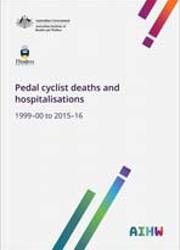Summary
This report looks at injury hospitalisations for pedal cyclists in 2015–16, as well as trend information for deaths and hospitalisations from 1999–00 to 2015–16.
In 2015–16:
- about 12,000 cyclists were hospitalised due to injuries sustained in a crash—this was 1 in 5 of the 60,000 people hospitalised due to injury in a land transport crash
- nearly 6 in 10 of hospitalised cyclists were injured in an on-road crash (6,900 or 58%), and the rest were injured off-road
- nearly 6 in 10 hospitalised cyclists had sustained a fracture, with the most common injury being a fractured upper limb.
Between 1999–00 and 2015–16:
- 651 cyclists died, an average of 38 deaths a year
- of cyclists who died, nearly 8 in 10 were aged 25 and over, and 9 in 10 were male
- nearly 160,000 cyclists were hospitalised, an average of more than 9,000 each year
- across all ages, the rate of hospitalisation rose by an average of 1.5% each year
- the proportion aged 25 and over rose, while the proportion aged under 25 fell
- modelling showed a non-statistically-significant decline in cyclist deaths of 1% per year.
Hospitalisation rates rose for cyclists, but fell for other road users
The overall rate of hospitalisation due to pedal cyclist injury rose between 1999–00 and 2015–16, though year-to-year fluctuations varied. The modelled trend for the whole period shows an average rate rise of 1.5% per year, though this rise was faster over the more recent 6-year period (an average increase of 4.4% per year).
This pattern differs from that for motor vehicle occupants, which fell by 1.3% per year, and for pedestrians, which fell by 2.2% per year.
While the hospitalisation rates of pedal cyclists for on-road and off-road crashes fluctuated over the 17 years, both rates recorded similar increases since 2010–11, of 4.7% per year for on-road and 4.3% for off-road.
Nearly 6 in 10 hospitalised cyclists sustained a fracture
Fractures were the most common type of injury (55%) sustained by cyclists of all ages, and were most likely to occur among hospitalised cyclists aged 45–64 (61%).
Of all cyclists who sustained a fracture, 6 in 10 fractured an upper limb. The highest proportion of upper limb fractures was among those aged 5–14 (78%), and the highest proportion of head and neck fractures was among those aged 0–4 (21%).
More older cyclists were hospitalised
Two participation surveys of people aged 15 and over found a large increase in cycling among older adults since 2001, while participation fell or rose only slightly in younger age groups.
Consistent with these findings, the age profile of cyclists who were hospitalised after a crash has changed since 1999–00—in more recent years, more were aged 25 and over, and fewer were aged under 25.
Older cyclists had more severe injuries
The severity of injuries sustained by cyclists generally increased with age. Compared with cyclists aged under 45, those aged 45 and over:
- were more likely to have life-threatening injuries
- stayed longer in hospital
- were more likely to be transferred to another hospital.
In severe cases, injured cyclists might need to be put on a ventilator to help them breathe. In 2015–16, cyclists required about 15,000 hours of continuous ventilatory support. Cyclists aged 45 or older consumed 90% of the total hours of ventilatory support, with more than half provided to those aged 45–64.
1 Introduction
2 Deaths of cyclists from their injuries
- How has the number of deaths changed over time?
- What injuries were sustained?
- Where did the deaths occur?
3 Hospitalisations of cyclists and other land transport users
- What was the sex and age of hospitalised land transport users?
- Did the crashes occur on-road or off-road?
- What were the counterparts in land transport crashes?
- What injuries were sustained?
- How serious were the injuries?
- How have land transport injury hospitalisations changed over time?
4 Pedal cyclists injured off-road and on-road
- What was the age and sex of hospitalised cyclists?
- What were the counterparts in pedal cycle crashes?
- How serious were the injuries?
- Where did the crashes occur?
- On what days of the week did crashes occur?
- How has the pattern of on-road and off-road crashes changed over time?
5 Injuries sustained by pedal cyclists
- What injuries were sustained?
- Which parts of the body were affected?
- How serious were the injuries?
6 Change in the age profile of hospitalised pedal cyclists over time
Appendix A: Data issues
Appendix B: Participation data
Appendix C: Other cases with mention of cycling
End matter: Acknowledgments; Abbreviations; Glossary; References; List of tables; List of figures; List of boxes; Related publications



